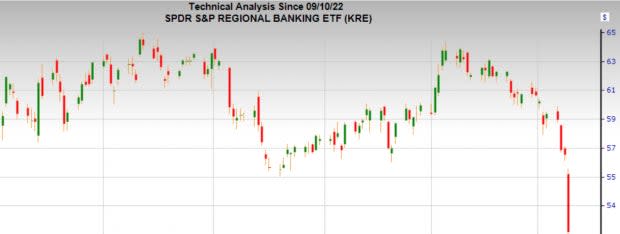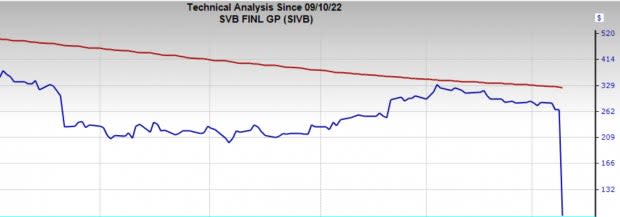Regional Bank Armageddon: What you need to know
A Snowballing Effect
On Thursday, the four largest banks lost a combined market cap of more than $50 billion. However, it was not the big, well-known banks like JP Morgan JPM, Bank of America BAC, or Goldman Sachs GS which lost the most on a relative basis. The Spdr S&P Regional bank ETF KRE saw its second-worst daily loss since 2011.

Image Source: Zacks Investment Research
Earlier this month, Silvergate Capital SI, a crypto-centric bank, began to plummet from already deeply discounted levels. Finally, on Wednesday, the company announced it would be conducting a voluntary liquidation and closing its doors. Though the news made headlines, investors who were paying attention likely saw the writing on the wall. Not only did the crypto-focused bank find itself in the middle of a crypto winter, but revelations also came to light that the firm had dealings with Sam Bankman Fried’s doomed crypto exchange FTX – causing a bank run on deposits which would ultimately lead to the firm’s demise.
No Longer an Isolated Incident
While the news pummeled shares of Silvergate, markets, and other banks, seemed to brush off the news as an isolated incident. Silvergate is involved in the hyper-speculative crypto space, after all. That is, until Thursday. On Thursday, Silicon Valley Bank SIVB collapsed by 60%, finally sparking fear throughout the banking industry.

Image Source: Zacks Investment Research
Like Silvergate Capital, Silicon Valley Bank caters to a more fringe side of the banking industry than most of its peers – start-ups, venture capital, and early-stage tech. That said, coming into the week, SIVB was the 16th largest bank in the United States. That’s a big deal.
A Rippling Effect
Silicon Valley Bank is cratering due to the collapse in the tech industry and soaring interest rates. Simply put, as their main customers came under macroeconomic pressure, SIVB saw deposits dry up almost completely, while withdrawals soared. Not a good combo for a bank which wants to stay solvent. Now, other regional banks such as Signature Bank of New York SBNY, First Republic Bank FRC, andPacwest Bancorp (PACW) are cratering as investors desperately try to manage risk. Meanwhile, the Russell 2000 Index ETF IWM, which is made up of more than 20% financials, took the worst hit out of the major indices and fell nearly 3% Thursday.
Could Investors Have Seen This Coming?
While most investors could not have predicted the collapse of Silicon Valley Bank, in hindsight, there were some major caution flags that could have kept investors safe, including:
· Most regional banks were below the 200-day: In an interview with Tony Robbins, Paul Tudor Jones once said, “My metric I look at for everything is the 200-day moving average of closing prices. I’ve seen too many things go to zero, stocks and commodities. The whole trick to investing is: “How do I keep from losing everything?” If you use the 200-day moving average rule, then you get out. You play defense, and you get out.”

Image Source: Zacks Investment Research
· Poor industry rankings: Zacks studies have shown that industry group health greatly impacts individual stocks. SIVB for example is part of the Banks – West Industry. The group is in the bottom 29% of all groups tracked by Zacks.

Image Source: Zacks Investment Research
· Relative weakness: Before plummetting, SIVB shares were down more than 30% year-to-date, while the S&P 500 Index was only down 5.4%. The fallout shows the importance of avoiding laggards.

Image Source: Zacks Investment Research
What Now?
The good news is that in the wake of the 2008 Global Financial Crisis, the U.S. government implemented stricter rules on bank lending, stress tests, and oversight. That said, the fallout from the current situation has yet to be fully realized. Investors should first and foremost focus on risk management. Cut losers and get your portfolio to a level where you are comfortable. Volatility is likely to pick up dramatically in the coming weeks. When the market speeds up, the best thing you can do is slow down. When the dust settles, opportunities will arise. A capital preservation mindset and patience are the name of the game for now.
Best Returns,
Andrew Rocco
Want the latest recommendations from Zacks Investment Research? Today, you can download 7 Best Stocks for the Next 30 Days. Click to get this free report
The Goldman Sachs Group, Inc. (GS) : Free Stock Analysis Report
Bank of America Corporation (BAC) : Free Stock Analysis Report
JPMorgan Chase & Co. (JPM) : Free Stock Analysis Report
Silvergate Capital Corporation (SI) : Free Stock Analysis Report
Signature Bank (SBNY) : Free Stock Analysis Report
First Republic Bank (FRC) : Free Stock Analysis Report
SVB Financial Group (SIVB) : Free Stock Analysis Report
iShares Russell 2000 ETF (IWM): ETF Research Reports
SPDR S&P Regional Banking ETF (KRE): ETF Research Reports

 Yahoo Finance
Yahoo Finance 